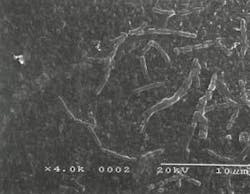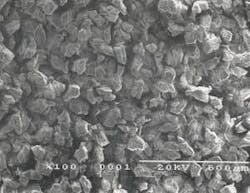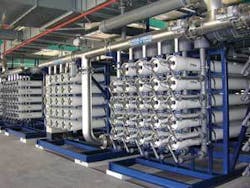Reverse osmosis membranes play key role in wastewater reclamation
Reverse osmosis (RO) membranes provide a cost-effective water purification solution for wastewater reclamation facilities. The Public Utilities Board (PUB) in Singapore, convinced by the results of a successful demonstration plant, installed two additional plants, the 32,000-m3/d Bedok and the 40,000-m3/d Kranji wastewater treatment plants, both using Hydranautics’ low fouling RO membranes.
Craig R. Bartels, PhD
Wastewater reclamation has become a viable alternative to supplement water supplies in water-short areas. In particular, membrane treatment has played an important role in purifying water cost-effectively.
Reverse osmosis (RO) membranes have been shown to significantly reduce total dissolved solids, heavy metals, organic pollutants, viruses, bacteria, and other dissolved contaminants. Experience from commercial membrane wastewater treatment plants has demonstrated that key design parameters must be followed to prevent rapid membrane fouling, and thus reduce high system maintenance costs and significant downtime. Current best practices include the use of ultrafiltration or microfiltration membranes to remove colloidal debris, maintain a chloramine residual to prevent biogrowth, select proper antiscalant chemicals, limit RO recovery rates to prevent membrane scaling, and use membranes which minimize organic fouling. Select conventional polyamide and low fouling membranes have been used successfully at plants such as the West Basin Wastewater treatment plant in California or the Bedok and Kranji plants in Singapore. These large-scale plants provide the basis for even larger plants, and greater contribution to the water supply in needy regions.
Membrane technology is playing an increasingly important role in the reclamation of municipal wastewater. Due to the growing demand for high quality water in urban areas, purification of wastewater is become one of the preferred means of augmenting water resources. In particular, high quality reclaimed wastewater can be used for industrial customers. For example, it is being used for making boiler feedwater and semiconductor process water. RO membranes have been proven to successfully treat such waste water and provide water that exceeds reuse quality requirements. Numerous large-scale commercial membrane plants are now being used to reclaim municipal wastewater. These plants include 50,000 m3/day at various West Basin, California, plants, the Kranji 40,000 m3/d in Singapore, and the 32,000 m3/d Bedok plant in Singapore. Some of these plants have more than 10 years of experience with membrane technology. Additionally, even larger plants have recently begun operation (380,000 m3/d plant for Sulabaiya, Kuwait) or will soon begin operation (270,000 m3/d plant in Orange County, California, USA, and the 170,000 m3/d Ulu Pandan plant in Singapore). The magnitude of these RO-based reclamation plants demonstrates the acceptance that this technology has gained recently.
A typical process for municipal wastewater consists of primary, secondary and tertiary treatments. The resulting effluent is low in turbidity and can be disinfected for discharge. However, this process does not reduce the level of dissolved solids and the water is not generally suitable for reuse. When tertiary effluent from a conventional treatment process is supplied to a RO system, it is common to have all forms of fouling - colloidal, biological, scaling and organic fouling. The coatings of foulant will impede water transport through the membranes. Early attempts to treat this water with RO membranes resulted in rapid fouling and required membrane cleaning as frequently as twice per week. This shortened membrane life and greatly increased operating cost.
In the past five to ten years significant research has demonstrated that RO membranes can run at very stable rates when operated at optimum conditions. This work was largely the result of studies at the Water Factory 21 in Orange County, California, and the large-scale demonstration for the past three years at the 10,000-m3/d plant in Bedok, Singapore.
Improved treatment process
Through careful research, the various modes of RO fouling have been addressed. Colloidal material is effectively controlled by the use of ultrafiltration (UF) or microfiltration (MF) membrane pretreatment.
Chlorine can be added prior to the membrane pretreatment to control biofouling in this step and again added after the membrane pretreatment to minimize biogrowth. RO membranes have little tolerance of free chlorine, but high levels of tolerance to chloramines. Chloramine concentrations of 2-4 ppm should be maintained in wastewater to prevent biogrowth in the RO membranes.
Scaling is controlled by a combination of suitable antiscalant chemicals, lower recovery and lower pH. It is not uncommon to have high levels of calcium, silica, phosphate, carbonate, and other ions that can form scale. One of the more problematic scalants is calcium phosphate. The mineral has very low solubility and phosphate concentrations can vary widely in municipal wastewater. Some scalants can be easily removed with cleaning, while others, such as silica, are very difficult to remove.
Finally, organic fouling can cause flux loss problems for RO membranes. Surface waters may contain only 2-5 ppm of dissolved organics, while wastewater may have 10 to 20 ppm of organics. These materials can adsorb on the membrane, causing flux decline. They can also react with antiscalant chemicals to form precipitate on the membrane. A recent report by Alexander et al. (6) shows that various membranes tested on wastewater have very different performance. In particular they found that conventional polyamide membranes like Hydranautics’ energy-savings ESPA2 can effectively treat wastewater with very stable flux and rejection. Low fouling membranes such as the low fouling LFC1 used at Bedok have also shown very successful performance on wastewater.
Recent pilot tests performed by Hydranautics further demonstrated the excellent performance of this design scheme when treating wastewater. At this municipal wastewater plant, secondary municipal wastewater effluent is treated by Hydranautics’ HYDRAcap UF hollow fiber membranes to produce RO feed water with a turbidity of 0.03 NTU. Both conventional low pressure polyamide membrane (ESPA2) and low fouling (LFC1 and LFC3) membranes have operated without flux loss and have maintained stable salt rejection for an extended operation.
Large-scale plant experience
The Bedok Demonstration plant is one commercial plant that has successfully used membrane-based reclamation. This plant has operated for nearly three years and typically produces 10,000 m3/d of high quality treated wastewater. The low fouling LFC1 RO membranes purify wastewater pretreated by MF membranes. The design flux was 19 lmh with a recovery of 85 percent. After some fine tuning, the plant operated with consistent performance, such that chemical cleaning of the first stage is done once every 130 days, while cleaning of the second and third stage is done once every 74 days on average.
Based on this experience of the demonstration plant, the Public Utilities Board (PUB) in Singapore installed two additional plants, the 32,000-m3/d Bedok and the 40,000-m3/d Kranji wastewater treatment plants, both using Hydranautics’ low fouling RO membranes. The process design for these two plants is given in Table 1.
Both plants have met water production and quality goals and have been operating since late 2002. The main difficulty encountered in the operation of the two plants was at the Bedok plant. This plant treated more difficult, high salinity water. During the initial operation of this plant, feed pressure rapidly increased during the first month of operation. Analysis of the flux values indicated that the problem was isolated to the second stage. The flux in this stage dropped from 13.6 to 6.1 lmh, while the flux in stage 1 was increased to compensate for the lower flow in stage 2. This clearly indicated that there was significant fouling of the elements in stage 2. Analysis of elements removed from the second stage indicated a combination of organic fouling and calcium phosphate scaling. Changes to the antiscalant have minimized this flux decline problem. The plant has operated for more than four years with the original membranes.
Conclusion
Membrane technology is being used for the large-scale reclamation of wastewater. Success of this new technology depends on proper pretreatment, chemical control and RO membranes that are resistant to fouling. With proper design parameters, certain conventional polyamide membranes and low fouling composite membranes have been shown to have stable flux and rejection over long operational periods, with time between membrane cleanings in excess of six months in many cases. This technology will be very important for communities who need to extend their water supply and for industries that require ultra-high quality water for their operation.
Author’s Note
Craig R. Bartels, PhD, of Hydranautics is based in Oceanside, California, USA. The author would like to thank the PUB of Singapore for providing plant operating data, and the Desalination Research and Innovation Partnership (DRIP) consortium that funded the pilot studies on conventional and low fouling membranes at Oceanside, California. Visit the website www.hydranautics.com for more information.



